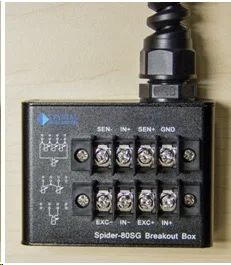A New Approach To An Old Sensor - A Spider Tames The Strain Gage
Download PDF | George Fox Lang | © Copyright Crystal Instruments 2016, All Rights Reserved.
A typical etched-foil strain gage
The diminutive strain gage is a marvelous sensor with some important advantages:
They are DC-sensitive
They measure response without influencing it
They identify modes from their attachment reactions
They are inexpensive
They are robust and long-lived
Strain gages have long been the premier analytic tool for static stress/strain analysis, characterizing the basic strength of structures. But, they also have important roles to play in dynamic structural studies. Strain is a displacement-like measurement. Strain gages provide excellent low frequency sensitivity. A strain gage is tiny, nearly mass-less and very compliant. When bonded to a typical structure, the gage hardly mass-loads or stiffens the thing being examined. Thus, it does not shift the resonance frequencies nor distort the frequency response characteristics as the use of an accelerometer can. When resonance frequencies and mode shapes are initially investigated, it is often necessary to use multiple response accelerometers (and/or excitation force locations) to assure all of the modes are captured. Strains measured at the attachment degrees-of-freedom (DOF) invariably capture all of the modes excited. A basic strain gage only costs about $6-$8 (in small quantities). This makes them ideal long-term monitoring sensors. Once installed, the gage is robust and will typically last as long as the structure upon which it is mounted.
However, the strain gage also has some distinct disadvantages:
They are DC-sensitive
They require skilled labor to install
They are not reusable
They are difficult to remove
DC-sensitivity has long been the Achilles heel of the strain gage for dynamic measurements. Clearly the dynamics information is contained in the alternating components of a measured strain signal. However, a small dynamic signal can be swamped by a large DC component. This DC component can reflect a large static load or it may simply reflect a temperature-induced error. It is not sufficient to merely AC couple the signal. To retain full dynamic range, it is necessary to eliminate the DC component at the earliest possible point in the measurement chain so that the full dynamic range of the analog electronics involved can be applied to the dynamic portion of the signal.
A “duffer” (including this author) may occasionally succeed in installing a strain gage, but the result won’t be pretty and alcohol will be required for more than the clean-up! A consistently satisfactory installation requires professional training and a proper kit of dedicated tools, chemistry and expendables. Most of us can learn to “lay” a gage properly, but only those with excellent hand/eye coordination and no muscular tremors can master soldering the leads to it. Yes, you can buy a gage with the leads pre-soldered, but they are expensive ($ 150 typical) and the lead configuration may not fit your application well. To use these marvelous little sensors effectively, you need a smart technician dedicated to their installation. An experienced technician can complete an installation in about 30-45 minutes. Once epoxy-bonded to the structure, the gage is quite permanent. They can be removed, but it is difficult and the host may require surface refinishing.
The Spider-80SG 8-channel strain gage front-end module
Here at Crystal Instruments, we anticipate an uptick in the sale of strain gages and related installation supplies as vibration analysts begin to once again embrace this tiny sensor for dynamic applications. Our recently released Spider-80SG module will be responsible for this. The Spider-80SG is the first really modern piece of strain gage instrumentation to be commercially developed in decades. It provides a long needed tight integration between high-speed, high-resolution digital measurement and today’s highly refined etched-foil strain gage. The Spider-80SG provides inputs (7-pin LEMO connector) for eight strain gage Wheatstone bridge channels. Each input may be configured as a single gage (quarter-bridge), two gage (half-bridge), or four gage (full-bridge) circuit and may use industry-standard 120Ω or 350Ω gages.
One of eight included Input Channel Adaptors, a breakout box to interface gage wires
Input Channel Adaptors (ICA) are provided to accept the wires coming from a single (1, 2 or 4) strain gage installation site and funnel them to a standard LEMO connector. Eight ICAs come with each Spider-80SG and additional units can be purchased for inventory. Periodically monitored strain gages can remain connected to a dedicated ICA, allowing simple "plug and play" analysis.
The "big picture" item here is that up to eight strain gage installations are managed by a single Spider-80SG. This includes bridge-nulling (output zeroing) and precision resistive-shunt calibration upon networked computer command. The output of each gage is (simultaneously) sampled with 24-bit resolution at a selectable sample rate of 0.48 Hz to 102.4 kHz. The resulting digital data streams are stored in 32-bit floating point format and are available for FFT, 1/nth octave or shock response spectrum (SRS) analysis. A monitoring system can include one or more Spider-80SG front-ends working in consort with Spider-80x 8-channel analog/IEPE (ICP) input modules. Spider-80SG is an extremely capable Ethernet-networked component with IEEE 1588v2 capability permitting it to synchronize its sampling and triggering within 50 nanoseconds to other Spiders 100’s of meters away.
This exciting new tool lets you integrate strain gage measurements into to your machinery monitoring program. It allows you to use strain measurements as protective Limit Channels in a laboratory shake test. It permits including strain DOFs in your modal surveys. In short, Spider-80SG brings the strain gage front-and-center in all of your dynamic measurements. And of course, it can also be used for all of those classical static stress/strain applications providing a new 21st century level of precision, convenience and networked-system integration.




